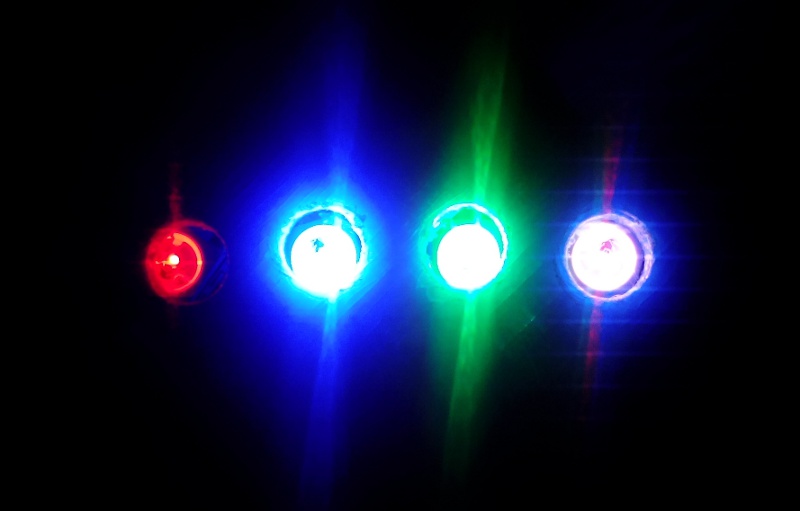[Luc] wanted to make a clock like no other. He knows that the territory is well-trod, especially in the area of minimalist design. Undeterred, [Luc] came up with a fresh design that uses the resistor color code to display the time. He’s calling it the Nerd’s Ultimate Watch.
It doesn’t get much more minimalist than four RGB LEDs. Each one illuminates in the color that represents the digit in the current time. For instance, I’m typing this sentence at 1:37PM. The clock uses 24-hour time, so let’s call it 13:37. Using resistor color code time, that’s 1, 3, 3, 7, or brown, orange, orange, violet.
In the interest of using the smallest possible microcontroller, [Luc]’s clock only displays the hour and minute. He was able to use a ‘Tiny85 to control the four RGB LEDs plus two buttons for setting the time. Three AAA batteries give him around eight hours of power. [Luc] would like to use a LiPo so it can be scaled down a bit. The code and the STL files for the case are available at his site.
From the minimalist to the ridiculously complex, we love a good clock build. Here’s another that relies on blinkenlights and an hourglass that flips itself.
















It may be easier to identify the color if the passing seconds are shown as well.
Check out this post, that uses a neopixel bar to display the time as HH:MM:SS:
http://timewitharduino.blogspot.ca/2015/05/ideas.html
Were you /really/ writing this at 1337 o’clock?
Yes indeedily!
Who could resist? I’m guessing people with anomalous trichromacy or dichromacy issues.
The E12/24 resistor color code was designed so that the colors have different intensities so that color blind people could read them as well. That seems to have been abandoned some time ago with all the cheep parts from China.
I am wondering where he got a reference for the RGB values he used ????
This lack of inclusiveness for color blind people seems to have dropped off over time. Probably because it can only effect color blind people, right? Well no.
The same has happens in the auto industry and there is now a model of car that uses a strip of yellow LEDs for indicators and I cannot see any contrast change when they are indicating and I have had several near misses especially at higher speeds on highways. There is nothing I can do about that so I went and upgraded my insurance as an accident is inevitable.
So in the same vein as “we don’t care about color blind people because it won’t effect me” – I Don’t care about people that drive cars with these indicators as they are modern plastic junk and I drive a old large ute (pickup) that will tear a modern car apart in an accident, using the extra volume (as it destroys the cabin of the modern car) to reduce the G forces I experience so that I am not harmed.
So pro tip: My color blindness is fairly typical so be aware that if you buy one of these cars with the row of yellow LEDs for indicates then, the statistical probability of dying in an accident increases by an order of magnitude because of something that *you* can’t see.
You don’t say which data is represented, but I’m assuming either speed or engine RPM. Couldn’t you pull this data from the OBD connector and generate a digital readout ? I won’t use the “A” word here but a quick search shows that there are several CAN-BUS shields available.
indicators, blinkers, turn signals. Other cars, not his.
For some reason, there’s some 90s Cadillacs that do the same sort of thing to me. They have the lights in residual fins and they blink slow, so it always seems to take me a couple of seconds to tell they are blinking.
That was my thought as well Bob since I have those issues. As a technician i can appreciate the project, I just wish I could see it.
I really like this concept. I’m now envisioning something with 6 1″ wide, 4″ or 6″ long frosted strips, about 1/2″ apart, with RGB leds behind them, and a diffuser.
something like this?:
https://hackaday.com/2010/01/15/know-your-resistors-tell-the-time/
Hmm, I had this idea about 10yrs ago, and it’s been on my project list ever since. I even managed to source a great piece of smoked plexi for a rear-projection screen. That’ll teach me to procrastinate. I’ll build it! Next year…
I saw an article here where someone made 7-Segment *segments* from Clear Acrylic (Plexi-glass?) and he just uses a sander to roughen the surface for a defused.
I figure smoked plexi will make it easier to approximate grey, brown, and black. Yeah…we’ll see.
It’s here –
http://hackaday.com/2016/09/10/careful-crafting-makes-diy-7-segment-display-shine/
The second digit is brown. Brown light? What does it look like?
Unless you’re viewing this on a weird e-ink display, of course…
ROFL you could have just said #654321
i smell toast
It’s a stroke!
+1
“There are… four… lights!”
I considered resistor color codes for my (now) CGA-clock. The reson why I didn’t do this is because colors should be brightness-invariant. That excludes having both brown and orange in a single palette.
https://hackaday.io/project/7724-cga-clock
Beaten to it by http://chronochrome.co.uk/. Not that it’s not still a cool hack.. (Chronochrome also has trouble with Brown :-) )
Not really a fresh design, somewhat kludged. Hackaday usually puts a couple of links at the end of an article to related things on HaD…
https://hackaday.com/2010/01/15/know-your-resistors-tell-the-time/
http://hackaday.com/2015/12/04/chromatic-clocks-with-a-steampunk-twist/
This clock is awesome for everything except TELLING TIME….
Looks like Idea is similar to http://www.rickard.gunee.com/projects/mixed/colorclock/